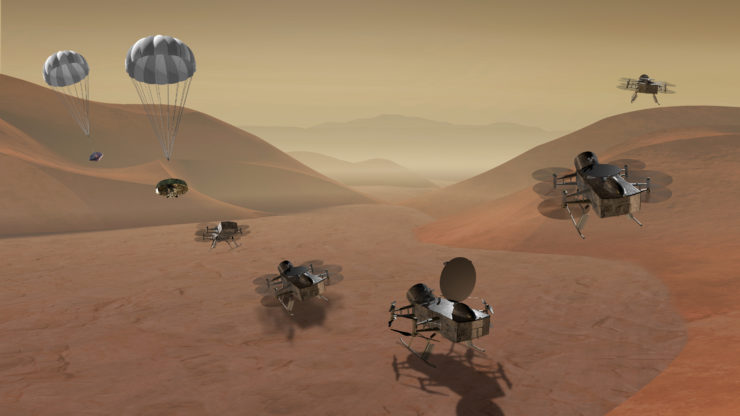NASA Preparing to Explore Saturn’s Largest Moon With Drones

NASA
NASA is currently planning a mission that will place a drone on the surface of Titan – Saturn’s largest moon. The name of the project is ‘Dragonfly’ and it is expected that it will take advantage of Titans dense atmosphere. The quadcopter will fly from location to location and capture data such as the moon’s chemistry and signs of potential life. The drone is designed like other regular drones on earth, but with 4 pairs of stacked rotors. This will make it easier for the craft to fly as fast as any hundred kilogram craft can across Titan’s surface.
Titan has been a mystery to scientists for decades and hopefully, Dragonfly will be able to explore hundreds of kilometers while scouting points of interest. It will take measurements as well as atmospheric conditions from the surface. Catherine Neish is an investigator and professor of Earth Science. She is assisting NASA in its bid to achieve this mission. The team is led by Elizabeth Turtle from John Hopkins Applied Physics Laboratory. Their main objective is to develop a drone that will investigate the surface of Titan.
Dragonfly is not so tiny but it is nimble. It’s about 2 meters long and is equipped with rotors that will give operators more control during flight times. For several years researchers have thought about exploring Titan with a balloon, small aircraft or rovers. Because each of these methods has its limitations that include mobility control and range, using the Dragonfly is seen as the absolute best choice.
The simplicity of using a small drone will make exploring more effective stated Neish. She also added that it is a bold and realistic option. Titan’s atmosphere is filled with a veil of methane and nitrogen. But in 2005, the Huygens probe (which was part of the Cassini mission) released images of the surface which has encouraged researchers to want to learn more about the moon.
Dragonfly will spend less time flying and more time gathering data on the two-year mission. Its main duties will be sampling for life and organic chemistry. It will also measure atmospheric conditions and conduct studies of the moon’s seismology. Dragonfly is one of the two missions that was shortlisted by NASA recently in its New Frontiers Planetary Science Program. The other project is called CAESAR (Comet Astrobiology Exploration Sample Return). The purpose of this program is to take a sample from a comet called 67P/Churyumov-Gerasimenko and bring it back to earth to analyze its origins and history.
|